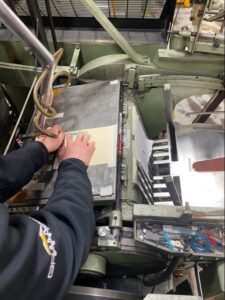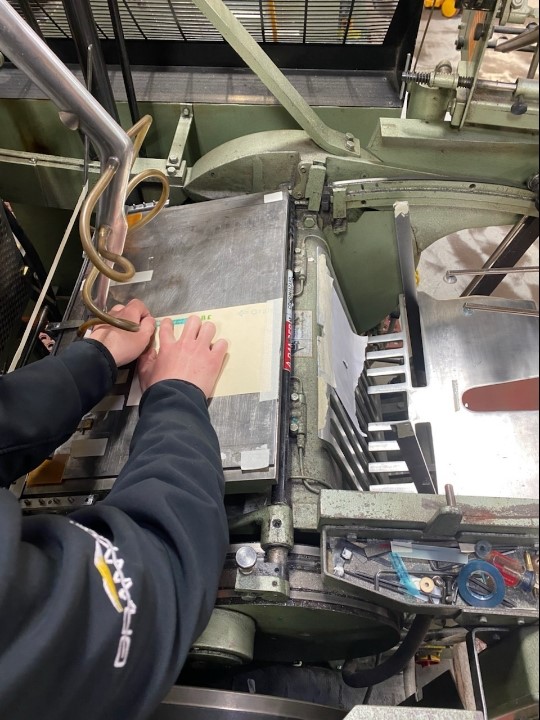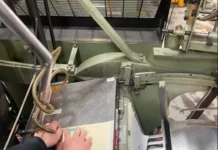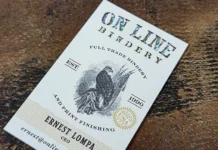By Liz Stevens, writer, PostPress
FSEA Executive Director Jeff Peterson recently queried a trio of industry experts about foil stamping and embossing challenges, including working with paper stocks, coatings, digital printing and more. Bertrand Hayoz, Bobst; Andy Dvorsky, Dvorsky Press Services and Sean Hurley, MCD, answered questions and offered advice for finetuning techniques, making jobs more cost effective and speeding up production.
Q: What are the challenges for foil stamping, coatings and embossing when it comes to paper stocks? Are there new paper stocks of particular interest? Are recycled stocks becoming more prevalent?
Bertrand Hayoz of Bobst replied that, as he trains customers, he finds that SBS board is the best choice and easiest to work with. Hayoz pointed out that fluted stock can be particularly challenging for foil stamping. “One thing that often will happen,” said Hayoz, “is that foil stamping will crush the flute, even when using a very thin flute, like a N or E flute. The paper will be crushed, the flute will be indented.” In some instances, this result will be acceptable, but in other cases, it is not acceptable to customers.
Dvorsky Press Services’ Andy Dvorsky brought up problems he has seen with recycled paper stock. “I have seen that a lot of recycled papers are really hard to stamp,” said Dvorsky. Dvorsky appreciates that new stocks are being introduced but wondered whether paper manufacturers are considering the embellishing processes that may be used on them. “Foil stamping, embossing and diecutting are not going away,” he said, and new ways of applying these techniques will emerge to suit different paper stocks.
 Dvorsky described problems encountered by a customer applying foil stamping to recycled stock. “The customer was having all kinds of trouble,” said Dvorsky. “The stock would stamp perfectly before being printed. But when the customer treated the paper stock, printed digitally and then tried to stamp it, the foils would not stick.” The customer had to put a primer on the paper after the digital printing, and then the foil stamping worked properly. “It is not the paper itself that caused the problem,” he said, “but all of the materials and processes involved that caused the problem.”
Dvorsky described problems encountered by a customer applying foil stamping to recycled stock. “The customer was having all kinds of trouble,” said Dvorsky. “The stock would stamp perfectly before being printed. But when the customer treated the paper stock, printed digitally and then tried to stamp it, the foils would not stick.” The customer had to put a primer on the paper after the digital printing, and then the foil stamping worked properly. “It is not the paper itself that caused the problem,” he said, “but all of the materials and processes involved that caused the problem.”
MCD’s Sean Hurley explained that when he consults with customers, he recommends a thicker stock when possible. “With a thicker stock,” he said, “you don’t have to worry about impression. With thin stocks, you may have to worry about impression, and they can be tougher to run.” Hurley said that smooth stocks typically are better and that some of the recycled stocks are very porous, which can cause issues. He noted that textured stocks are more difficult to work with, but that they allows for more creativity and can be fine for routine applications. “I see synthetic stocks as being more difficult,” Hurley said. “They can be tough to run vs. a smooth cover-weight sheet.” Stocks, such as Plike and Touche, have become very popular but can be challenging. Stocks that are translucent also can present challenges. A more expensive stock doesn’t necessarily mean it will perform well. Hurley advised checking with paper vendors for the stamping and embossing specs for their stocks and asking for recommendations.
Q: UV coatings can produce cracking problems and create other challenges for foil and embossing. Have UV coatings improved? What recommendations, especially from a pre-planning standpoint, do you have for dealing with coatings and laminates for use with foil and embossing?
Dvorsky has seen UV coatings improve over the years. “There is stampable UV,” he said, “but a problem with conventional UV is that it continues to include silicone. That can introduce a challenge for stamping.” A shop might be running a conventional UV on its equipment, Dvorsky explained, and then switch over to an over-stampable UV. “They will wash the machine up,” said Dvorsky, “put a stampable UV in and then try to foil stamp over it. They may have to wash the machine out five times before running the stampable UV through because of contaminant from the standard UV coating in the machine.” Dvorsky recommended doing pre-planning for using UV coatings with foil: Talk to vendors to get their specs and make sure that coatings are stampable, see if it is possible to avoid stamping on the coating and then use spot UV or apply the UV after the foil. “There also have been foils,” said Dvorsky, “that are formulated to stamp on UV coatings. Talk with your foil supplier. Talk with your coating supplier. Talk with your paper supplier. It is all in the planning to make a job beautiful.”
Hurley agreed that a small amount of regular UV coating can contaminate a large amount of gluable, stampable coating. “We tell customers that what they want is a gluable, stampable coating,” he explained. Hurley recommends also checking dyne levels. “When we receive jobs involving a UV coating,” he said, “we check the dyne level. We test sheets ahead of time, before they go on press, using dyne pens. If you have low dyne,” he said, “you probably have to think about going to a specialty foil, and that can be a more expensive product that is made for problematic jobs.”
Hurley has seen problems with darker colors of ink that are printed and coated inline to speed up the printing process, but this can lead to the ink below the coating still being wet. “When the face of the die hits the coating, foil might not adhere because the ink is not set, and this causes foil adhesion problems. We see a fair amount of this and it can be challenging.” Hurley noted that this problem can occur with UV cured inks as well; the key is the topcoat. “We prefer a gluable/stampable coating and a higher surface dyne level,” he said. “The chemistry from the printer needs to be compatible with foil stamping over the UV coating.” He stressed that communication is critical for success.
Hayoz offered another solution to address the dyne level problem. “Do one pass first to stamp without foil and then a second pass to put the foil on,” said Hayoz. “Sometimes it works and sometimes it will not.” Hayoz’s suggestion prompted Hurley to offer additional ideas. “In jobs where a perfect mirror image is not required, it may be possible to run a separate pass on press with a die with a slight texture on the die face to break the surface of the coating slightly. That can help the foil to bond on the second pass.” Hayoz weighed in with a final strategy and mentioned for large foil stamped areas, the makeready can be built up like a pyramid to the center of the image and it will help the air disperse on every side of the areas that are being foiled.
Q: Digital printing continues to grow and create challenges with foil stamping and embossing. What recommendations do you have for pre-planning on press and working with digitally printed sheets?
Hurley recommended talking with the customer about advanced testing when working with digitally printed sheets. If the customer has used the same inks and coatings previously, he suggested asking for a few sheets to have ahead of time to test the foil. Hurley also suggested working with foil companies to learn about their latest or updated products, as well as asking for recommendations. “With newer digital equipment and newer UV inkjet, we have had better results,” he said. He did say that the registration systems with digital printing can cause challenges for conventional grippers and side guide registrations. “Something with drop-dead, tight registration can be a challenge because of the way digital printing equipment uses optical registration,” he explained.
Hayoz commented that some machines have a registration system which makes it possible to register by a printed or stamped mark on the sheet as opposed to registering by the sheet’s edge. There is emerging foil machinery that includes a built-in registration system, along with a different method for guiding sheets through the machines.
Dvorsky offered advice on using a primer for foil stamping over stocks with digital printing. “What I have seen is that darker inks are harder to stamp on because so much color has been put down onto the paper,” he said. “Priming the paper after the ink has been printed definitely helps, and it also can help to have a soft-touch or other type of laminate over the digital printing before foil stamping.”
Q: Print runs are getting shorter and there is increasing concern about waste and rejects. What do you recommend, from a production standpoint, to keep rejects down when working with foil and embossing?
Hurley stated, “A big thing is to track the waste so that your operators know that it is important. You might even save waste on a job that you know you are going to be tight on. If you look at the incoming packing slip to see what the count was and you end up short on the job, you then have a way to determine how much you had in waste, because you
tracked it.”
Hurley also recommended being more efficient when using sheets in makeready. “Depending upon how many operations are involved in a job, you will need to do an additional press makeready for each operation to get up and running,” he said. Each makeready adds even more spoilage and waste. Also, you might ask your customers to send their own makeready from the printing press – clearly marked as ‘makeready’ – and use it prior to using good sheets.” He also pointed out that some substrates are very expensive per sheet and that using a less expensive paper of a similar thickness for makeready might cut down costly waste.
Hayoz added his thoughts about decreasing rejects and waste. “We see a lot of operators who just take the good paper stock right from the beginning to do their makeready and they waste a lot of sheets.” Hayoz suggested that operators use the makeready sheets from the printing for the entire set-up process, but he noted that it sometimes does require multiple sheets. “It is not only on the first stamping process,” said Hayoz, “it is all the way along the line. Cutting, gluing and all the different processes. That will save a lot of sheets.”
Hayoz stated also that, depending on the quality required, keeping the machines and the environment scrupulously clean can reduce waste that inadvertently is generated. “A tiny piece of dust or something on the foil stamp or on the sheet, and the picky customer rejects the sheet,” said Hayoz. “When you move the sheet around, you have to keep everything perfectly clean.” He stated that if a speck of dust gets stuck between the stamping or on the top of the stamping before a coating is applied, the sheet may be rejected by a demanding customer. “We have a maintenance program that we recommend customers follow,” he said. “Mostly, they have to know when to clean the inside of a machine; not only the outside of the machine but the inside, too.” Hayoz also recommended covering loads of paper with plastic sheets to keep dust off the surfaces.
Dvorsky added, “I look at it as an operator. Operators are craftsmen, so waste is impacted by the attitude of the operators.” Dvorsky brought up the advantages of having multiple machines in a shop. “When you are setting up a job that has to go through the press five or six times, set it up on three different machines – tracking the registration throughout – that reduces waste.”
Dvorsky advised that having well-trained operators makes a difference and that poor training can result in waste. Dvorsky reiterated that “reducing waste requires the right state of mind, the right operators, regular maintenance of the machines, cleanliness and making sure that counters are working – all of that has an effect.”
Q: Today’s customers want jobs faster and faster, so foil and embossing equipment must run at high speeds. Any recommendations to decrease makeready time on the press, or things to do so that setup from one job to the next goes as fast as possible and the equipment can run at optimal speeds?
Hayoz commented that he is a stickler for saving time by having jobs queued up and ready to run. “It is not your operator’s responsibility to go looking for the next load,” he said. “Before you finish one job, the next job already could be by the machine, not at the other end of the building.” Hayoz said that documentation is a must for speeding up operations. “When you have a job change,” he said, “write down all the data from the job, especially if it is a repeat job. That way, you can set up everything on the machine before you start to do the job.” Hayoz recommended taking advantage of machines that can retain job specs in memory. “You may have a machine that memorizes the old job and you can bring it up each time. Preparations like this can be done in advance so that when you finish one job, the next job will be there. Having the next job prepped and letting the operators know what job is next can speed things up. That makes a big difference on makeready time and being able to run quickly and smoothly.”
Dvorsky wrapped up his advice with some valuable suggestions. “Having a second honeycomb is great, so that you can start setting up your next job. Having the press maintained and the platen parallel will reduce your makeready times,” he said.
“Having all the tools on hand, having the press parallel, level, having the operators know how to do proper makereadies, these all help,” said Dvorsky. “Operators can get lazy and do things the easy way, but that is not always the best way. I had a customer running a scratch-off job. The operator decided to use masking tape as makeready over his makeready board, which caused all kinds of issues. The job looked awful, and you couldn’t scratch the scratch-off properly. So, it is important for operators to maintain the press, have all the tools needed and run the press at optimal speeds.”
Hurley threw in a few last bits of advice for speeding up operations. “I suggest leveling the press, doing maintenance, even tracking the speeds,” he said. “If you have trained operators that are good at what they do, they are true craftsmen in many ways, and giving them incentive to run faster is important.”
This article was based on a panel presentation – “Troubleshooting Foil Stamping Challenges: Ask the Expert,” – which was part of FSEA’s Online Spring Summit in the summer of 2021. Thank you to panel members Andy Dvorsky, Dvorsky Press Services; Bertrand Hayoz, Bobst; and Sean Hurley, MCD for their contribution.





